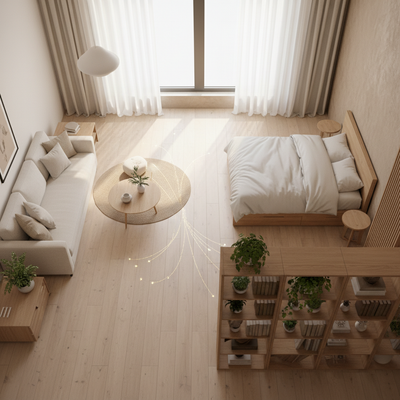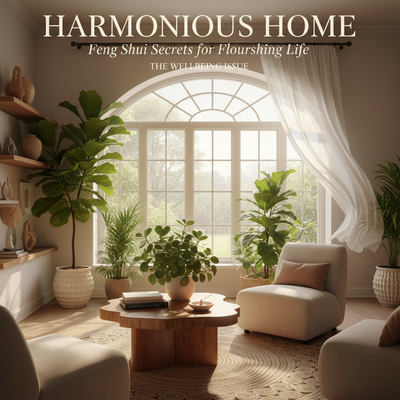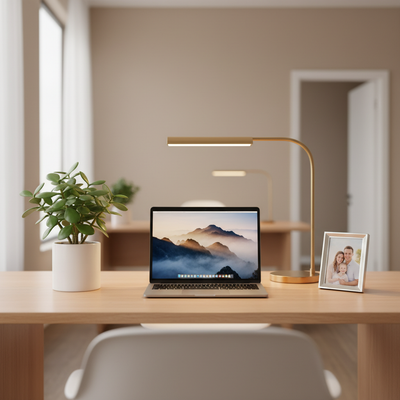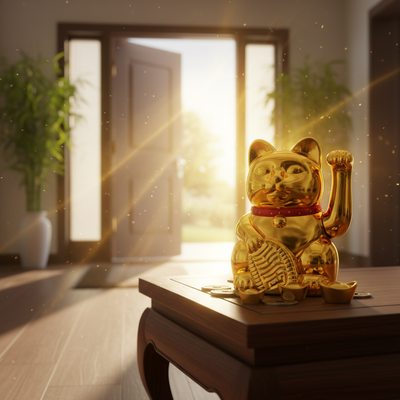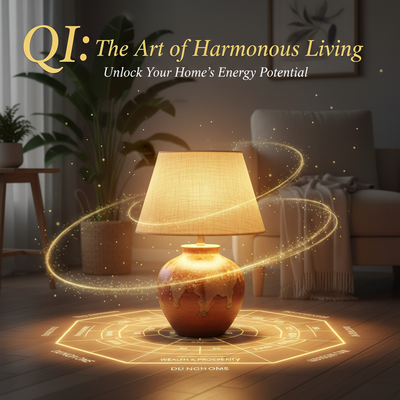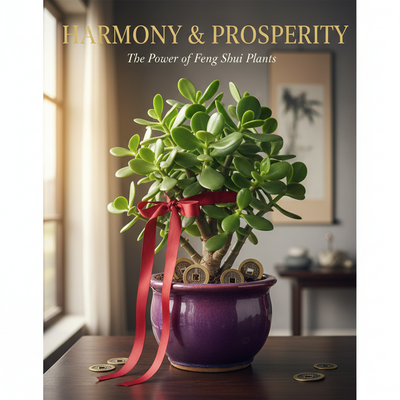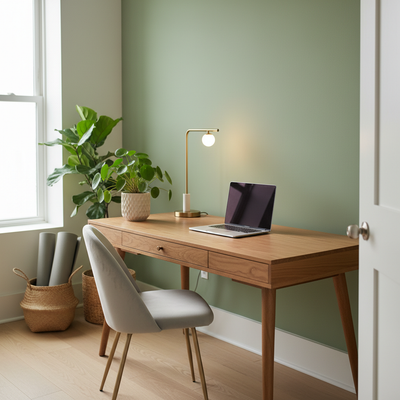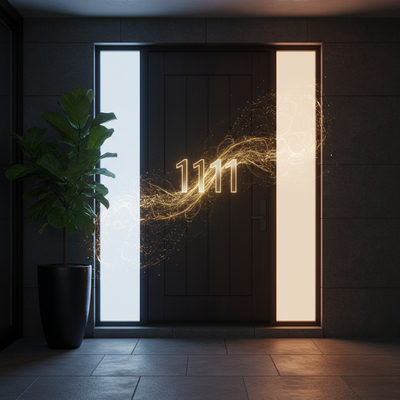Your living room is much more than just a place with a couch and a TV. It's the center of your home. It's where your family comes together, where you spend time with friends, and where you relax after a busy day. The energy of this room affects your whole house. Feng Shui is a powerful, old practice that helps us create balance in our spaces, and color is one of its strongest tools. It's not about strict rules that never change, but about understanding energy and making things balanced.
This guide will show you the feng shui colors to avoid for a living room and explain why they can mess up the good energy in your space. More importantly, it will teach you how to pick colors that help create connection, relaxation, and happiness. To give you the quick answer you're looking for, here are the main color groups to be careful with when decorating your living room:
- Too Much Bright Red
- Too Much Black and Dark Blue
- Too Much Gray and White
- Unbalanced, Intense Greens
- Dull, Muddy Browns
Now, let's look at the deeper ideas behind these suggestions so you can make good choices for your own home.
Understanding The Five Elements

In Feng Shui, color is never just about how things look. Each color shows a type of energy that matches one of the Five Elements: Wood, Fire, Earth, Metal, and Water. These elements work with each other in natural cycles, and the goal for any space—especially an important room like the living room—is to create a good balance among them.
The Five Elements work in two main cycles. The Productive Cycle is a creative, helpful sequence: Water helps Wood grow, Wood feeds Fire, Fire creates Earth (ash), Earth makes Metal, and Metal carries Water. The Destructive Cycle is one of control and opposition: Water puts out Fire, Fire melts Metal, Metal cuts Wood, Wood breaks up Earth, and Earth blocks Water.
Understanding this isn't about memorizing hard formulas. It's about knowing that if you have too much of one element, you can balance it by adding another. A living room usually works best with a mix that helps social connection (Fire), stability (Earth), and calm (gentle Wood or Water). Too much of one thing, like too much Fire energy, can lead to arguments, while too much Water can make people feel tired and lazy.
To make this idea clear, here is a simple breakdown of each element and its matching energies.
| Element | Associated Colors | Energy & Qualities |
|---|---|---|
| Wood | Greens, Browns | Growth, Healing, Vitality, Flexibility |
| Fire | Reds, Bright Oranges, Pinks, Purple | Passion, Energy, Social Interaction, Fame, Transformation |
| Earth | Yellows, Beiges, Sandy Tones, Taupe | Stability, Grounding, Nurturing, Support, Self-Care |
| Metal | Whites, Grays, Metallics (Gold, Silver) | Clarity, Precision, Logic, Organization, Efficiency |
| Water | Blacks, Very Dark Blues | Wisdom, Introspection, Flow, Calm, Deep Emotion |
With this foundation, the advice on which colors to avoid in your living room will make sense. It's not that these colors are "bad," but that their strong energy can easily take over a space that's meant for family harmony and relaxation.
A Guide To Problem Colors
This is the main part of our look into feng shui colors to avoid for a living room. We will break down each color family, explaining why using too much of it can create problems and what specific effects it might have on the feeling of your home's main gathering space. Remember, the key problem is often using too much on large areas like walls or big furniture pieces.
Aggressive Reds & Oranges
The Fire element, shown by red and bright orange, is important for a lively home. It brings warmth, passion, and gets people talking. A small touch of red can be wonderfully energizing. However, when used as the main color—think all-red walls or a huge red sectional sofa—the Fire element gets out of control. A living room is a place where family members with different energies and from different ages come together to find common ground and relax. Too much Fire energy can make this nearly impossible, creating a space that feels more like a war zone than a peaceful place. It constantly stimulates the nervous system, preventing real rest.
Potential Effects:
* More arguments, disagreements, and conflict.
* A feeling of restlessness and not being able to truly relax or calm down.
* Can feel overwhelming, raising stress levels and blood pressure.
* May contribute to hyperactivity, especially in children.
Dominant Black & Dark Blue
Black and the deepest shades of blue are the colors of the Water element. Water energy is about thinking deeply, wisdom, and the deep flow of emotion and intuition. In a balanced space, a touch of black can add depth, sophistication, and a sense of grounding. However, when used in large amounts, the energy becomes overwhelming and stuck. An all-black or dark navy living room can feel like you are underwater in deep, dark water. This "drowning" energy can be oppressive, leading to feelings of sadness, isolation, and a lack of motivation. While it might seem stylish and dramatic at first, living in such a space day after day can drain the life from the room and the people in it, discouraging the very social connection the living room is meant to encourage.
Potential Effects:
* Creates feelings of sadness, gloom, or even depression.
* Leads to a lack of social energy, motivation, and forward movement.
* Can make a room feel much smaller, heavier, and more oppressive.
* May create a sense of isolation among family members.
Excessive White & Gray
White and gray are the colors of the Metal element, which controls logic, clarity, organization, and precision. This is why these colors are so popular in offices, laboratories, and minimalist designs—they help clear the mind for focused tasks. While a crisp, clean look is appealing, a living room dominated entirely by white and gray can feel sterile, cold, and emotionally empty. It lacks the nurturing, supportive energy that a family space needs. Think of a hospital or a corporate meeting room; they are efficient but not places you'd choose to connect emotionally with loved ones. The Metal element, when there's too much, can cut through emotional warmth, creating a formal and unwelcoming atmosphere that keeps people at a distance.
Potential Effects:
* Creates a lack of emotional connection and warmth.
* Can feel lonely, stark, and isolating.
* Lacks the nourishing Earth and gentle Wood energy needed for a family space.
* May subtly encourage criticism and analytical thinking over empathy and relaxation.
Unbalanced Bright Greens
This might seem surprising, as green is generally considered a positive color in Feng Shui. Green represents the Wood element, which is all about growth, healing, and vitality. Natural, soothing shades of green—like sage, olive, or mint—are fantastic for a living room. The problem happens with greens that are overly bright, fake, or jarring, such as lime green or neon green. This kind of intense, unnatural green brings a fast-moving, chaotic version of Wood energy. Instead of promoting steady growth, it can feel restless and messy. It can upset the senses rather than soothe them, potentially stopping calm communication and creating an undercurrent of frantic energy that works against a peaceful home environment.
Potential Effects:
* Can feel restless, chaotic, and messy.
* May upset the nervous system rather than calm it.
* Stops calm, thoughtful communication.
* The fake nature of the color lacks the grounding quality of natural greens.
Murky Browns & Beiges
Browns and beiges are classic Earth element colors. The Earth element is crucial for a living room, as it provides grounding, stability, and a sense of being nurtured and supported. So, what's the problem? The issue lies not with the colors themselves, but with their specific shade and tone. When browns and beiges become too murky, dull, or "dirty" looking, they represent stuck Earth energy. Instead of feeling supported, the space can feel heavy, dated, and uninspired. This energy can lead to a feeling of being "stuck" in old patterns, a lack of vitality, and a general dullness in the atmosphere. The goal is to use warm, sandy, or rich earthy tones, not shades that feel lifeless and heavy.
Potential Effects:
* Leads to a feeling of being "stuck" or a lack of progress.
* Drains inspiration and vitality from the space.
* Can make the atmosphere feel heavy, depressing, and dull.
* May feel dated and lack the fresh energy needed for a thriving family.
Balancing Unwanted Colors
What if your living room already has one of these challenging colors, and a full repaint or new sofa isn't possible? Don't worry. Feng Shui is not about expensive, drastic changes; it's about smart, intentional adjustments. You can easily "cure" or balance the energy of a room by using the Five Element Productive Cycle to your advantage. Here's how to reduce the effects of these dominant colors.
Balancing An Overly Red Room
If your room feels too fiery and arguments happen often, the solution is to bring in the Earth element. In the Five Element cycle, Fire creates Earth (ash), so Earth energy naturally calms and grounds excessive Fire without putting it out completely.
- Bring in earthy-toned decor. A large rug in a sandy beige or warm taupe can instantly ground the room.
- Use ceramic or pottery. Place plants in solid, square ceramic pots, or display pottery as decorative objects.
- Add pillows and throws in earthy colors like terracotta, soft yellow, or warm beige to break up a large red sofa.
Lifting A Dominant Black Room
If your living room feels heavy, dark, and isolating due to too much black or dark blue, you need to add life. The Wood element is the perfect cure. In the productive cycle, Water nourishes Wood, so adding Wood energy gives the overwhelming Water a purpose, absorbing its excess and bringing in vitality.
We often see this with large black leather sofas. Instead of telling clients to replace an expensive furniture piece, we advise them to add life around it. A large, vibrant plant like a Fiddle Leaf Fig placed next to the sofa, or a light-colored wooden coffee table set in front of it, can completely transform the energy from oppressive to sophisticated.
- Bring in living plants. Tall plants, hanging plants, and fresh flowers are powerful Wood element cures.
- Add wood furniture. A coffee table, side tables, or bookshelves made of a light-to-medium-toned wood will lift the energy.
- Use green or light brown accent pillows and throws to add life directly onto the dark furniture.
Warming A Sterile White Room
For a living room that feels cold, sterile, and lonely due to too much white and gray (Metal), the key is to add warmth and life. You can do this by bringing in both the Fire and Wood elements. Fire melts Metal in the destructive cycle, which helps control its sharp energy, while Wood adds softness and vitality.
- Add colorful artwork with warm tones. A large piece of art featuring reds, oranges, or pinks can become a focal point and fill the room with Fire energy.
- Use soft-textured pillows and throws in warm colors. Think blush pink, soft yellow, coral, or a warm, creamy beige.
- Add wooden elements and plants to bring in the Wood element, which softens the hard edges of the Metal energy.

For complex spaces where multiple elements are out of balance, a personalized consultation can be very helpful. The THE QI FLOW team specializes in analyzing a room's unique energy map and providing tailored solutions that work for your specific home and lifestyle, ensuring the changes you make have the most positive impact.
Best Colors For Your Living Room
Now that we've covered the feng shui colors to avoid for a living room, let's focus on the positive. Choosing the right colors can transform your living room into a sanctuary that actively supports your well-being. The best color combinations are typically those that create a sense of balance, drawing mainly from the Earth, Wood, and gentle Fire elements.
For A Calm And Healing Space
If your main goal for the living room is for it to be a peaceful retreat for relaxation and quiet connection, focus on a combination of Earth and gentle Wood element colors. This color scheme is grounding, nurturing, and restorative.
- Soft Blues and Greens: These colors promote healing, calm, and peace. They remind us of nature and help lower stress levels. Think of shades like sage green, pale sky blue, or a muted teal.
- Sandy Beiges and Warm Taupes: As foundational Earth tones, these colors create a stable, secure, and nurturing atmosphere. They are the perfect backdrop for a peaceful family life.
- Soft Yellows: A gentle, buttery yellow brings in the cheerful, sun-like energy of the Earth element without being overstimulating like a Fire color. It creates optimism and contentment.
For A Social And Joyful Space
If you want your living room to be a center of lively conversation, laughter, and warm hospitality, aim for a color scheme that balances the grounding Earth element with touches of gentle Fire energy. This combination helps connection and joy.
- Peachy and Apricot Tones: These are soft, inviting versions of the Fire element. They encourage conversation, friendliness, and a sense of community without the aggression of a true red. They are perfect for creating a welcoming glow.
- Terracotta: This deep, earthy color is the perfect mix of Fire and Earth. It's grounding and stable yet warm and sociable, making it an excellent choice for creating a strong sense of community.
- Rich Creams: A wonderful alternative to stark white, a warm, rich cream has natural warmth that is more inviting and comforting. It provides a bright and airy feel while still being soft and nurturing.
The Power of Nuance
It is important to understand that no color is naturally "bad" in Feng Shui. The principles we've discussed apply mainly to dominant colors used on large surface areas like walls, large rugs, or bulky furniture. The context and proportion are everything.
Many of the colors on the "avoid" list can be powerful and positive when used as small accents. A bright red candle (Fire) can add a spark of passion. A black picture frame (Water) can add depth and focus. A single gray pillow (Metal) can add a touch of sophistication. The key is balance. A simple guideline is the 80/20 rule: let your room be 80% made up of neutral, supportive, and balanced colors, and use the remaining 20% for accents of more powerful elemental colors. This allows you to include your favorite vibrant shades without letting their energy take over the space.
Painting A Picture Of Harmony
Ultimately, choosing the right Feng Shui colors for your living room is about creating balance, not about fearfully following a rigid set of rules. By understanding the Five Elements and the energy that each color carries, you are empowered to move beyond simply decorating and begin intentionally creating an environment that supports your well-being.
Trust your intuition. The principles of Feng Shui are a guide to help you tune into the energy of your space. Pay attention to how a color makes you feel. Use this knowledge to create a living room that not only looks beautiful but feels like a true sanctuary—a place of harmony, connection, and joy that you and your family will love coming home to.
